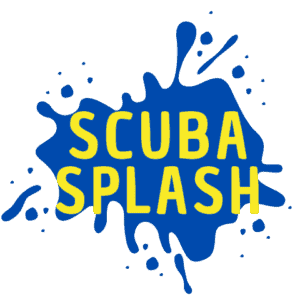Palau offers fantastic diving year-round with consistent water temperatures and lots of amazing dive sites.
Located in the western Pacific Ocean, Palau is one of the best places to scuba dive in the world. They offer colorful reefs, robust marine life, drop-offs, caverns, shipwrecks, and blue holes.
There are well over 50 dive sites in Palau so I did some research and combined it with my own personal experiences. Here is a list of the very best places to dive in Palau.
12.) Jake’s Seaplane
Japanese Navy Floatplane
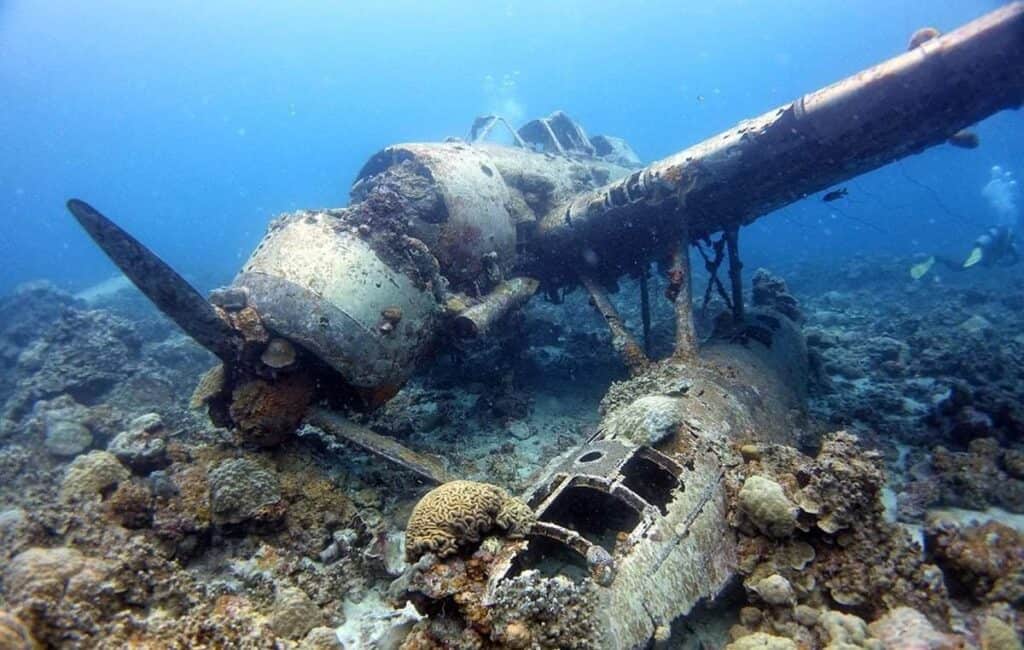
Expect to See: Seaplane, artifacts, lionfish, tropical fish, pufferfish, octopus, oysters, clams, coral, sea sponges
Skill Level: Beginner
Best Time to Go: November-May
Jake’s Seaplane is an interesting dive. These types of wrecks are rarer and make for unique diving. Especially when they still contain artifacts like this one.
The seaplane sits upright on the ocean floor at a depth of 45 feet (14 m) and is 320 feet (97 m) long.
The plane was built in 1941 and was sunk in 1944 when it was hit during WWII. It is a single-engine, double floatplane with three seats. This pane was primarily used for land and sea bombings as well as rescue missions and general transportation.
The artifacts at the dive site include a radio, ammunition and a small bomb in the front cockpit. This might go without saying but please don’t touch anything especially the bomb.
The plane is in really good condition with most of it still intact. The tail and right float are detached and lay 6 feet (2 m) away from the main wreckage site.
The entire plane is almost fully encrusted with oysters, calms, and both hard and soft coral formations. Black coral, sea whips, staghorn, and sea sponges are just a few varieties present.
Large schools of glassfish, octopus, giant pufferfish, and several species of coral are everywhere you look. You’ll defiantly want a camera for this interesting site.
Jake’s Seaplane is great to dive year-round but the best visibility is from November through May, 33-49 feet (10-15 m). It’s also a popular night diving location. The water temperature is a constant 80 F (26 C) year-round.
Fast Fact: Palau became the world’s first shark heritage site in 2009 and has since seen a drastic increase in shark populations. The most common species are grey, silvertip, hammerhead, and leopard.
11.) Devil Fish City
Manta Ray Heaven

Expect to See: Rays, reef sharks, black snapper, barracuda, tropical fish, copper sweeper baitfish, sea fans, coral
Skill Level: Beginner
Best Time to Go: January-April
Manta rays are the main attraction at Devil Fish City. The Rays come to be cleaned by butterflyfish and cleaner wrasse.
This dive site is known as a cleaning station for many species of fish. Larger marine life such as rays and sharks come to have their body, gills, and mouths cleaned by smaller fish. It mutually benefits both parties since the larger fish remove bacteria and parasites from their bodies and the smaller fish get a meal.
Remember to stay relaxed and still around the manta rays at the cleaning stations. They do not like being approached so keep a safe distance and hang out to watch as they come and go in large numbers.
Apart from this, there are lots of beautiful soft coral formations and tons of sea fans to look at. At several coral heads, there are hundreds of copper sweeper batfish huddled together.
There are also large gardens of sea whips and green tubastrea corals where tons of species of tropical fish can be spotted.
There is often a strong current at this site so it is advisable to bring along a reef hook. The best times to go are during slack high tide and incoming tide.
10.) Helmet Wreck
WWII Shipwreck

Expect to See: Shipwreck, artifacts, lionfish, stonefish, eel, oysters, clams, shrimp, anemone, coral
Skill Level: Beginner- wreck diving certified
Best Time to Go: October-May
Helmet Wreck is one of several wreck dives around Palau. It’s also one of the best and most commonly explored by divers. The ship is believed to date back to WWII and wasn’t discovered until the late 1980s.
The ship is 189 feet long (57 m) and 30 feet (9 m) wide. It is believed that it was confiscated by the Japanese and sunk during WWII. Some estimate that it was sunk in 1944 when US aircraft bombed the area.
The ship has no documented name so it got it’s current name ‘Helmet’ from the helmets that sank with the ship and still remain there today.
The wreck depth varies from 45 feet (13 m) at the stern and 110 (33 m) at the bow. There are many coral species growing on and around the wreck. These include brain, lettuce, and staghorn.
Visibility is not always the best due to the silky bottom which can sometimes get disturbed reducing visibility.
The ship sits upright on the ocean floor and is covered in tons of colorful coral. The main cargo hold can be explored if you are wreck diving certified and feel like having a look inside.
The best part of this shipwreck is that it is full of artifacts from the war. There are lots of ammunition, rifles, machine guns, 3 fighter plane engines, belts, shoes, lanterns, medicine bottles, sake bottles, and helmets that sunk with the ship.
From 2013 to 2014 countless hours were spent trying to remove ammunition and depth charges from the site. Most were recovered but certainly not all of them.
Remember that it is illegal to take anything from the site especially ammunition. They are also unstable and could explode if handled. Plus, we want to preserve sites like these for the next generation of divers. Divers are always welcome to take photos and videos but leave it at that.
9.) Peleliu Wall
Black and Yellow Coral

Expect to See: Coral, sea fans, canyons, caves, drop-off, sea fans, silvertip and reef sharks, turtles, jacks, barracuda, sea snakes, tropical fish
Skill Level: Advanced
Best Time to Go: November-April
Peleliu Wall is the deepest wall dive sites in all of Palau. The stunning terrain includes canyons and caves cut into the sides of the wall. There are bright yellow and black coral, sharks, caves, massive sea fans, and tons of tropical fish species.
Peleliu Wall is most famous for its large sea fans and beautiful coral formations. Not to mention the huge fish and shark population. Bull, tiger, and hammerhead are sometimes seen at this dive location too.
The wall begins at about 30 feet (9 m) depth and extends down to 90 feet (27 m). Keeping the wall to your left you can see lots of larger pelagic fish coast by as they ride the current.
Sharks can be seen around 33 feet (10 m) and caverns are at 98 feet (30 m) deep.
The current is very strong and often the strongest in all of Palau. Reef hooks are commonly used to help stabilize and secure divers. It’s not the best place for true beginners due to the currents.
8.) Chandelier Cave
5 Cave System with Tunnels

Expect to See: Caves, tunnels, soldier fish, cardinal fish, shrimp, crab, sea sponges
Skill Level: Beginner
Best Time to Go: Year-round
Chandelier Cave is a network of 5 separate caves that are connected by tunnels. Four of the five caves are relatively easy to navigate. The fifth is a bit more challenging.
All the caves contain limestone formations that include both stalactites and stalagmites. There are air pockets inside so it is possible to come up for a breather or to just have a look. Mind your head when surfacing because you might hit your head on a stalactite on the way up.
The cave entrances are located 12 feet (3 m) below the surface and the maximum depth is 33 feet (10 m). The dive starts off in complete darkness so you’ll need to have a flashlight. After several minutes a faint light from the cave entrance will become visible.
Exploring each cave is easy through the system of tunnels that connect them all. However, keep in mind that some spots are pitch black with zero visibility. It can be frightening for anyone who gets anxious or is not overly confident as a diver.
As mentioned previously, 4 of the caves are easily explored while the 5th is more challenging. This caves tunnel is not underwater. This means to enter it, you will need to remove your dive equipment and walk through the tunnel.
It’s always best to go with a local and skilled guide if you are unsure of navigation but still want to explore the site. It’s located in Malakal Harbor which is less than 1 mile from the city of Koror.
7.) Siaes Corner
Vertical Drop-Off and Black Coral

Expect to See: Whitetip and grey reef sharks, rays, turtles, barracuda, jacks, snapper, shrimp, tropical fish, tunnel, cavern, coral
Skill Level: Beginner and up
Best Time to Go: Year-round
Siaes Corner actually consists of a tunnel, wall, and corner along the Rebotel reef. It’s located 17 miles (27 km) northwest of Ulong Island and takes 30-40 minutes to reach by speed boat.
This vertical drop off begins 10-15 feet (3-4 m) below the surface and plunges to 160 feet (49 m) deep.
Siaes Corner is not visited as often as it should be. It’s an amazing location that more people should explore. Actually, you could use that to your advantage and dive a pristine site that is never crowded.
Along Siaes Wall and Corner, you can expect to see lots of grey reef sharks, and schools of barracuda, jacks, and snapper. Both green and hawksbill turtles are commonly seen along the wall as well.
Visibility is 45-120 feet (14-36 m) depending on the current. The average depth for this site is 30-60 feet (9-18 m).
Siaes Tunnel is a massive cavern with three openings all leading into the center chamber. It’s located at 80 feet (24 m) depth and only for advanced certified divers. This is due to the depth of the tunnel beginning at 80 (24 m) feet and maxing out at 140 feet (42 m).
The entrance to the tunnel is visible starting from 60 feet (18 m) depth where big-eyed jacks, snapper, and grey nurse sharks roam.
Black coral and huge gorgonian sea fans adorn the tunnels and there are usually several sharks resting on the sandy bottom.
There is plenty of light within the tunnels and lots of little crevices to look through. Be mindful of your depth because it’s tempting to exceed recreational limits.
The current along the wall and corner are strong, especially during the incoming tide. So keep that in mind when descending and ascending. Reef hooks are commonly used at this site. Be sure to only connect it to dead coral. However, there is no current inside Siaes Tunnel.
6.) New Drop Off
Reef Plateau

Expect to See: Whitetip and reef sharks, eel, rays, turtles, snapper, barracuda, scorpionfish, tropical fish, anemones, sea sponges, sea fans, coral, drop-offs
Skill Level: Beginner and up
Best Time to Go: Year-round
New Drop Off is actually the meeting point of two separate drop-offs meet and create a plateau corner.
Dives start off along the wall as you make your way toward the corner plateau. The plateau is at 30 feet (9 m) but the reef wall actually begins just below the surface of the water. The wall continues to drop off after the plateau and goes down to 450 feet (137 m).
The wall itself is adorned with tons of coral formations and tropical fish species. It has huge gorgonian sea fans, sea sponges, and lots of soft coral formations. Turtles, sharks, and spotted eagle rays are commonly seen by the dozen.
There are two entry points for this site, north and south. Both are equally amazing. For divers that enter on the southern section there is a cavern at 120 feet (36 m).
Keeping the wall to your right, about 15-20 minutes into the dive you will approach a corner. Just before that if you look down you will see a canyon going down the face of the reef. Inside this canyon is a cavern that you can explore. Be mindful of air and depth if attempting to enter the cavern.
Visibility at the New Drop Off is 50-120 feet (15-36 m) depending on the water conditions. Water temperature is between 80-87 F (26-30 C).
The New Drop Off is located off Ngemelis Island and takes 45-50 minutes to reach via speed boat.
The shallow parts of the drop off have little to no current and are great for beginners. The deeper you go the more intense the current becomes though. Always keep an eye on your depth since it’s a very deep site with a sometimes strong current.
5.) Blue Hole
Passageways Connecting to a Blue Hole

Expect to See: Coral, reef walls, caves, sharks, rays, barracuda, giant clams, tuna
Skill Level: Beginner
Best Time to Go: November-April
Blue Holes in Palau is actually a site with four connecting holes within a reef system. It’s by far one of the most unique dive sites in all of Palau and certainly the most fun.
Divers usually enter through the main hole and make their way down to the bottom at 120 feet (37 m). Taking in the sights and exploring all the small crevices. From the main hole, there are 2 exit points. One is referred to as the ‘window‘ at 45 feet (14 m) deep and the other is a larger opening at 85 feet (26 m) depth.
Both exit points are filled with lots of fish, sharks, coral, and reef systems to explore. Upon exiting, divers then move onward to a nearby site called Blue Corner which is a diverse reef wall filled with over 1,400 species of fish, 700 species of coral, and 7 species of giant clams. You definitely want to visit Blue Corner but more on that later since it did make the list.
You might be wondering about the fourth hole. That hole is off the main entry point at 80 feet (24 m) deep and leads to the entrance to another cave. It’s such a narrow opening that you won’t confuse it with the other wider exit hole nearby.
This narrow passageway leads to the ‘Temple of Doom‘. As the name might suggest it is a dangerous cave for uncertified divers and should not be attempted unless you are adequately trained in cave diving. There have been deaths here due to untrained divers attempting to explore the Temple of Doom.
Visibility ranges from 60-150 feet (18-46 m) which changes due to varying current patterns. It takes 50-70 minutes to reach the site via speed boat.
The currents change frequently in the area, particularly around Blue Corner. These currents can sometimes be very strong so be mindful of this especially if you are a beginner.
You can find out more on blue holes here: World’s Best 11 Blue Holes For Scuba Diving
4.) Ulong Channel
Lettuce Reef and Giant Clams
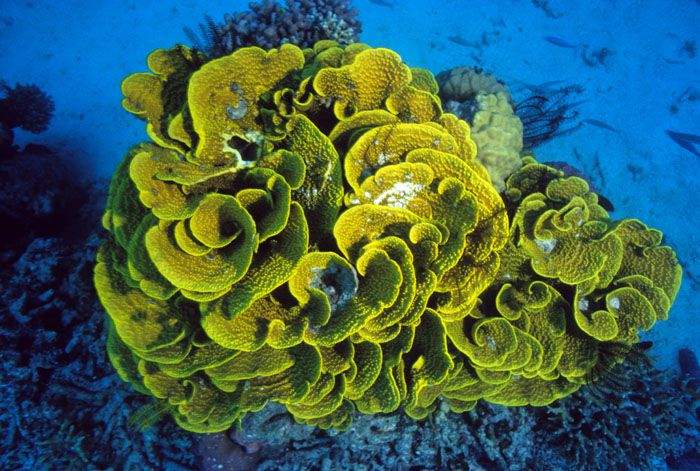
Expect to See: Reef sharks, rays, barracuda, jacks, snapper, grouper, triggerfish, tropical fish, giant clams, coral
Skill Level: Advanced
Best Time to Go: November-June
Ulong Channel is considered one of the top drift diving sites in the world. It’s a shallow channel in the barrier reef off Ulong Island filled with coral heads and other coral formations.
The site is located on the west side of Ulong Island. The channel averages a width of 108 feet (33 m) but expands to 1,640 feet (500 m) as it feeds into a massive lagoon.
There are several patch reefs and sea fans to explore. There is even a massive 23 foot (7 m) high lettuce reef coral patch. The lettuce reef is fragile so be sure to keep a safe distance.
The reefs start just below the surface of the water and extend downward to the sandy seafloor.
Turtles and giant clams are accompanied by large schools of barracuda, snapper, and jacks. Yellow margin aka pineapple triggerfish often nests in the sandy bottom of the channel. They do get defensive if anything goes near their area. These triggerfish can grow up to 24 inches (60 cm) so make sure to give them their space if they ask for it.
From April through June thousands of grouper migrate here to spawn during the full moon. If you are in the area it’s worth checking out.
Maximum depth is 42 feet (13 m) and visibility is 33-98 feet (10-30 m). The water temperature is pretty consistent all year round and stays right around 82 F (28 C).
Currents at Ulong Channel are strong and unpredictable. They have been known to change directions during the course of a dive. Drift dives aren’t always the best sites for true beginners especially when currents suddenly change direction. Be sure you have a bit of experience before heading to this location.
3.) Big Drop Off
Plunging Drop-Off
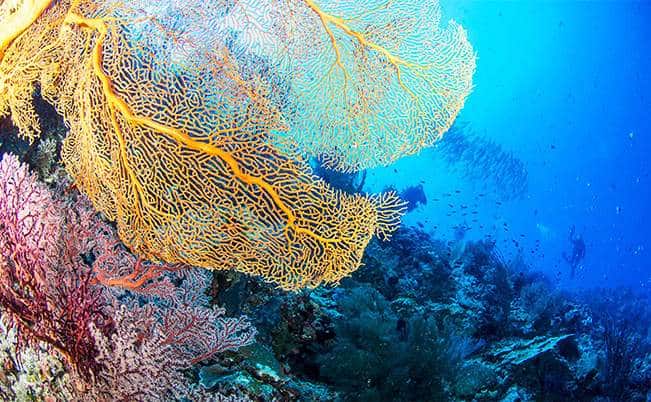
Expect to See: Reef, nurse, whitetip, and leopard sharks, turtles, stonefish, lionfish, tropical fish, anemones, sea sponges, sea fans, coral
Skill Level: Beginner and up
Best Time to Go: Year-round
The Big Drop Off is a vertical wall that plunges to 900 feet (274 m) deep and runs parallel to Ngemelis Island. It’s a very popular site that offers vibrant coral and tropical fish.
It’s full of both soft and hard coral formations as well as huge sea fans. Tropical fish cluster throughout the wall and sharks teeter back and forth in deeper waters.
Fun Fact: At this dive site there is a 6 foot (2 m) ball connected to a large steel chain. This ball and chain were used during WWII to prevent the Japanese from entering the waterways. You can find it near the mooring buoy.
The Big Drop Off is also a popular snorkeling site and offers some spectacular pink and purple leather coral.
It’s considered an easy drift dive but the current sometimes changes direction. If this happens just go with it and allow yourself to change direction with it.
Water temperatures are 79-82 F (26-28 C) and visibility is 49-98 feet (15-30 m). There is a lot of rainfall from June to July but the site is good for diving year-round.
Both lionfish and stonefish are present at this site and both are very poisonous. The camouflage themselves very well so be mindful of where you touch or if rest yourself against anything.
2.) German Channel
Coral Formations and Manta Rays

Expect to See: Reef and whitetip sharks, turtles, rays, eels, jacks, barracuda, snapper, lionfish, shrimp, giant clams, octopus, tropical fish, anemone, coral
Skill Level: Beginner
Best Time to Go: November-May
German Channel is a man-made cut in the reef that was created during WWII by the Germans. During this time the Germans occupied Palau and mined for phosphate. The cut was made by blasting through the reef to make a channel for transportation reasons.
The site is located 23 miles (37 km) southwest from the city Koror.
New coral formations have since flourished in the area which sometimes makes it hard for large boats to pass through.
The channel is too narrow to actually swim through so dives start at the southwest section and descend vertically.
The hard coral formations are large and very vibrant and there are lots of schools of tropical fish and plenty of sharks swirling around.
There are cleaning stations at the German Channel so lots of manta rays and sharks come by to get cleaned by wrasse and butterflyfish. These stations are 85 feet (20 m) below the surface along sandy plateaus. They are easy to spot because that’s where the rays will be.
Depth is 33-131 feet (10-40 m) and the water temperature is almost always around 82 F (28 C). Expect visibility to be 65-85 feet (20-26 m).
1.) Blue Corner
Shark Haven
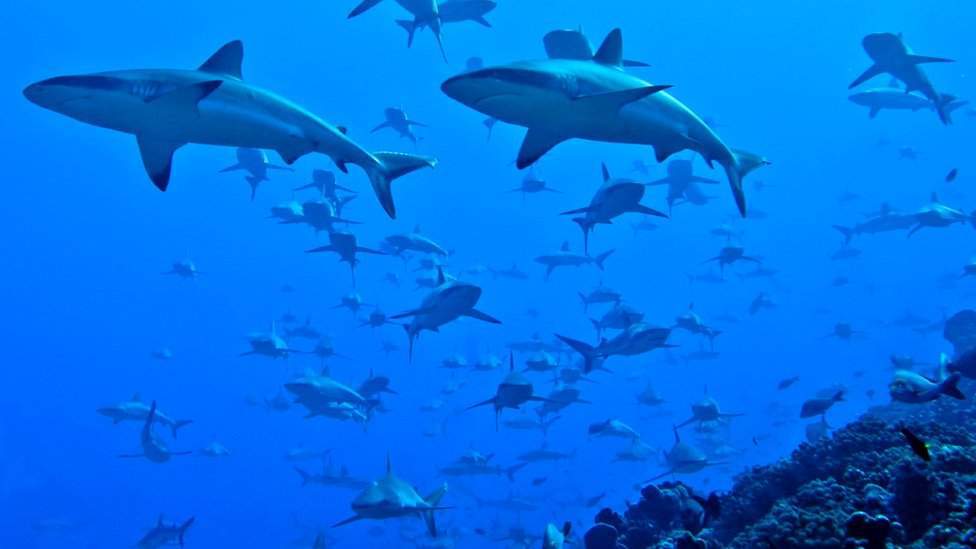
Expect to See: Whitetip, hammerhead, and reef sharks, rays, eel, turtles, snapper, jacks, barracuda, grouper, triggerfish, tuna, tropical fish, anemone, coral
Skill Level: Advanced
Best Time to Go: November-May
Blue Corner is by far the most famous diving site in all of Palau. Everyone who comes to the area dives here and it’s for good reason.
Even the most seasoned divers find the massive fish and shark populations astounding. There are over 1,400 different species of fish at this site alone. You can also expect to see anywhere from 20-50 sharks on one single dive at Blue Corner.
Blue Corner is located on the northwest section of Ngemelis Island. There are 700 different species of coral and 7 species of giant clams at Blue Corner. I wonder how many you can spot.
The terrain is primarily a flat reef plateau that stretches outward 600 feet (183 m) before abruptly dropping off into deeper waters. You can also expect to see small sandy hills and tunnels.
The start of the dive is along a shallow coral shelf with vertical walls. After swimming about 330 feet (91 m) along the coral shelf you will find a cavern filled with huge gorgonian sea fans.
These gorgonian sea fans and cavern are located 80-90 feet (24-27 m) below the surface. Hammerhead, tiger, and bull sharks hang out in the deeper sections of the dive site.
In Blue Corner, there are 13 different species of sharks including hammerheads, blacktip, whitetip, silvertip, blue, tiger, and grey. It’s actually some of the best places to dive freely alongside sharks.
More on shark diving: Best 18 Places To Scuba Dive With Sharks
Depth ranges from 25-98 feet (8-30 m) and visibility is 45-60 feet (14-18 m). The water temperature is 77 F (25 C). It takes 50-70 minutes to reach the site via speedboat.
The Blue Corner has strong currents and is considered a drift dive. Currents are unpredictable and sometimes very strong so for these reasons it’s best to have some experience before coming to the Blue Corner.
